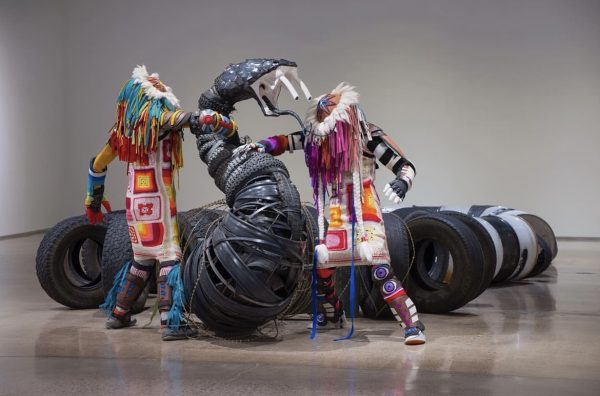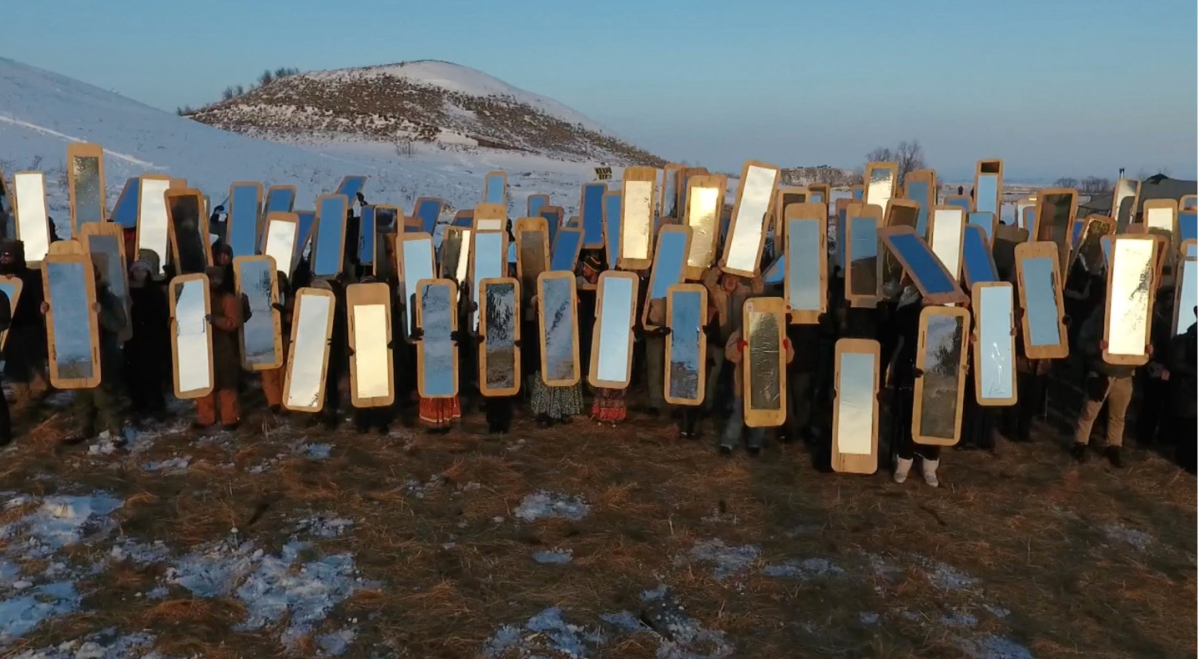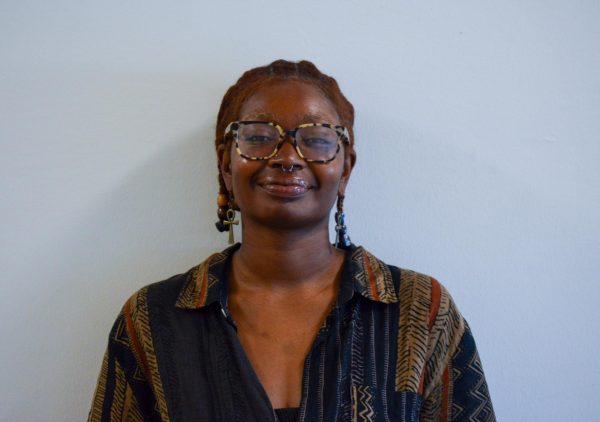On Nov. 9, Arts Alive San Diego State University presented “Creative Activism: Exploring Artistic Engagement in American Indigenous Activism,” concluding the campus initiative’s discovery series of guest speakers.
The event featured an artist talk and panel conversation with New Mexico-based artist Cannupa Hanska Luger, a graduate of the Institute of American Indian Arts in New Mexico who gained acclaim for his powerful art installations.
The artist shared his wisdom from a long-spanning art career, including acknowledgments as a 2023 Soros Art Fellow, 2022 Guggenheim Fellow and 2021 US Artist Fellowship Award winner.
A slideshow behind the artist presented highlights of his works, which have been exhibited nationally and internationally. Luger’s work across multiple mediums include ceramics, steel, fiber and repurposed materials.
Kim Stringfellow, a professor from the School of Art and Design, gave him an introduction.
“Luger activates speculative fiction, engages in land-based acts of repair and practices emphatic response through social collaboration,” Stringfellow said.
As an enrolled member of the Three Affiliated Tribes of Fort Berthold, he foregrounds his indigenous worldview to create art of massive proportions.
Luger introduced himself with a question in his native language of Hidatsa, which he then translated into English as, “Who are you and why have you come?”
Behind him, the screen shows captivating displays of his art, which includes unique imaginings of the future based on Indigenous imagery. His art installations offer a new perspective on what the future can look like.
“The work that I make is through an Indigenous lens, but the only thing special about that is that it’s all that I know,” Luger said. “I was raised that way. This is the filter in which I experience the world.”

Luger’s work challenges our imagining of basic aspects of our reality, including what it means to inhabit the land we’re on.
“The perspective that I have is (that) this land has never belonged to me or us,” Luger said. “It was never ours in the way we understand the term. We belonged to the land.”
His work has to deal with what he calls “Indigenous futurism,” a type of speculative fiction based on the Indigenous worldview of his upbringing.
Luger questions our view on the future and what the art we consume says about it. In confronting traditional tropes of science fiction, he establishes the uncertainty of the future.
“What does it look like if our future does not funnel into this homogenous union that seems to be the only form of utopia that science fiction has presented for us?” Luger asked.
Luger’s ideas force us to question what art is in a post-colonial world. His art confronts the “myth of America,” which he identifies as the false promises and limitations of free choice.
“The freedom that the country sells to you is that you have the freedom of choice,” Luger said. “You get to choose this or that. That’s an individualist form of freedom.”
Luger offered a unique perspective on life, applying ancient values to the complexity of modern American life.
“There’s a form (of freedom) that’s much older than that,” Luger said. “It’s a form that plants know, sea creatures know, life knows in general, and it’s what do I do for us? Give me the freedom of knowing my purpose here, in this place, in relationships, in community.”
Luger’s art reflects his imagination for an alternative to the established systems of life in an industrialized world. He prompted us to challenge him and his art, inviting a dialogue and answering students’ questions with excitement.
“I’m interested in us imagining something different,” Luger said. “I’m interested in us actually tearing open the expectations of what our future looks like and getting involved in its creation. And I believe that creation starts with imagining.”
Luger was born at the Standing Rock Reservation in North Dakota, and he bases his art on an imagination of the future based on the wisdom of past generations.
He sees art as a mere anchor in time representing a larger idea that’s been passed down through generations.
“I’ve been thinking about this with sculpture, that sculpture could be a time machine,” Luger said. “That any work of art, can hold the history and narrative of the present and because of the system we navigated, presently preserves these things far in the future. That scope of influence is going to affect people, who knows where.”
He spoke further on how he learned to detach himself from the long history of American Indigenous appropriation, referencing how he had to heal from the trauma of seeing objects from his history displayed in museums.
“There’s a part of me that’s like, ‘I want all of those back for my people,’” Luger said. “But I’m thinking of them as material, as objects. That’s something I had to learn. That they weren’t relatives, that they weren’t processes, that they weren’t stories, that they weren’t information (but) that they were things.”

Luger’s passion for art as a means to change the world provides a unique perspective to speculative art. He wants to offer new ideas to future generations as a means of carrying on the past.
“I think a lot of the indigenous knowledge that I’m trying to apply is technology,” Luger said. “Technology is just an idea that’s based on paying attention to the land and rather than trying to dominate it facilitate it. See what those systems are and apply those systems. And in that space, I can imagine a bright future.”
Luger’s view of art brought a refreshing angle to SDSU, with a focus on the Indigenous perspective of life and spirituality. His words motivated compelling audience questions and discussion.
Discussion panelist William “Memo” Neccrecio, SDSU professor and director of Master of Arts in Liberal Arts and Sciences (MALAS), found Luger’s work “ludicrous”.
“In the best sense of the word,” he Neccrecio said. “In the Nietzschean sense of the word –in that it was seriously playful, dealing with the most critical and vital issues –indigeneity and racism and classism– but with an almost playful touch. Ludic, the root word of ludicrous, means play, but I like to think of this serious play as a form [of] game theory and Cannapu’s work always moves in this direction.”
Luger attempts to offer a different outlook on the world to the people consuming his art.
“His bold visual storytelling presents new ways of seeing our collective humanity,” Stringfellow said about Luger’s works.
“We are nature,” Luger said. “We are an extension of it.”
To Luger, the future is in our hands as a collective human race. He wants his art to inspire an ideal world.
“My ideas are not the end of it. These are one of many ideas. I’m excited about the ideas that are contributed through our collective imagining. How can we imagine something better than what we’re doing presently?”
For more information on Luger’s work, visit here.








